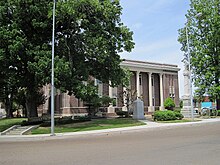Haywood County, Tennessee
| Haywood County, Tennessee | |
|---|---|

Haywood County Courthouse
|
|
|
Location in the U.S. state of Tennessee |
|
 Tennessee's location in the U.S. |
|
| Founded | 1823 |
| Named for | John Haywood |
| Seat | Brownsville |
| Largest city | Brownsville |
| Area | |
| • Total | 534 sq mi (1,383 km2) |
| • Land | 533 sq mi (1,380 km2) |
| • Water | 0.9 sq mi (2 km2), 0.2% |
| Population | |
| • (2010) | 18,787 |
| • Density | 35/sq mi (14/km²) |
| Congressional district | 8th |
| Time zone | Central: UTC-6/-5 |
| Website | Haywood County |
Haywood County is a county located in the U.S. state of Tennessee. As of the 2010 census, the population was 18,787. Its county seat and largest city is Brownsville.
Haywood County was created from part of Madison County in 1823–24, and was named for Tennessee judge and historian John Haywood. The state legislature designated Brownsville as the county seat. Haywood County was later reduced in size, when both Lauderdale and Crockett counties were created from its territory.
For much of the county's history, agriculture, especially growing cotton, was the basis of the local economy. Before the Civil War, this was accomplished by a plantation system based on the use of slave labor. After Emancipation in 1865, the plantations were largely broken up, and tenant farming and sharecropping became the way that people controlled their labor.
According to the U.S. Census Bureau, the county has a total area of 534 square miles (1,380 km2), of which 533 square miles (1,380 km2) is land and 0.9 square miles (2.3 km2) (0.2%) is water.
Haywood County is situated on the southeastern edge of the New Madrid Seismic Zone, an area with a high earthquake risk.
From 1940 to 1970, the county population declined. Many blacks left after confrontations and the murder of Elbert Williams in 1940 related to black attempts to register to vote. In addition, mechanization of agriculture reduced the need for farm workers, and other African Americans left as part of the second wave of the Great Migration. A total of more than five million migrated out of the south during those decades, moving especially to the West Coast for the expanding defense industry, and to industrial cities for work opportunities.
...
Wikipedia
